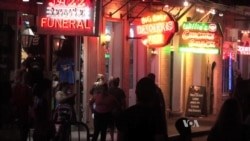A decade after Hurricane Katrina brought New Orleans to the brink of death, the city has come back strong.
When levees failed to hold back Katrina’s storm surge, nearly 80 percent of the city flooded. More than 100,000 homes were destroyed.
“Ten years later, we are proud to show off what we think is one of the greatest renaissances of any city in history, anywhere,” said Andy Kopplin, New Orleans’s deputy mayor.
Katrina changed the city’s population mix. The city has a smaller but more diverse population.
Allison Plyer, who keeps track of statistical changes for The Data Center in New Orleans, said the city has around 385,000 residents now, down 100,000 from the 2000 census.
“The city has about 100,000 fewer African Americans than it did pre-Katrina,” she said. “It also has about 10,000 fewer white residents. We have more Latinos and Asians than we did.”
Latinos came here from Texas and other states for temporary jobs in construction – but many stayed.
“In Louisiana, post-Katrina, the rebuilding of homes took so many years that, ultimately, many people settled here,” Plyer said.
Many young people who came as volunteers in the relief effort also stayed.
The new demographic mix has transformed some areas, but Plyer said the authenticity of the city’s culture is not at risk.
“New Orleans has not turned into Disneyland or something very different than it was pre-Katrina,” she said. “It is still very much New Orleans.”
Money, young people boost recovery
New Orleans is a younger city today, Kopplin said, partly because it attracts young people with its culture, music and food.
“We have almost 500 more restaurants in the city of New Orleans today than we did before Katrina; so we have fewer people, but more restaurants,” he said.
For people with an education or valuable skills, getting a job here is not difficult, thanks to revitalized industries and heavy investment in start-up technology companies.
“We are number one, per capita, in terms of in-migration of people under 25 with a college degree,” said Michael Hecht, President and CEO, Greater New Orleans, Inc., a regional economic development agency.
New Orleans and the state of Louisiana have benefited from federal recovery funds and huge investments by private capital firms both domestic and foreign.
“Louisiana is now number one per capita [in the U.S.] in foreign direct investments,” said Hecht. “We have had investments over the past few years from Europe, from Asia, from South America.”
“Trade is strong,” said Kopplin. “The Port of New Orleans has doubled its throughput since 2009, they announced the other day, but we are also branching out into new industries.”
The challenge for city leaders is to bring the benefits of change to all sectors of this diverse society.
“While we are seeing increasing employment rates among white men, black men have employment rates at about 50 percent, which is as low as they were pre-Katrina,” Plyer said.
City and state officials have started programs to train unskilled workers and improve schools, but reducing the income disparity likely will take many years.
Tourists return
Officials also say the tourism sector – disrupted for months after Katrina struck – is again flourishing.
“We had 9.3 million visitors last year and we can continue to increase that market,” Kopplin said.
“Tourism is one of the mainstays of our economy,” said Mark Romig, president and CEO of the New Orleans Tourism Marketing Corporation. “Roughly 80,000 individuals work in the tourism industry. Visitor spending last year alone was $6.8 billion.”
While 90 percent of tourists coming to New Orleans are from the United States, Romig noted that the impact of international visitors is significant.
“We find that the international visitor will usually stay longer than the domestic visitor,” he said, “and so they will stay longer and perhaps spend more.”
In the aftermath of Hurricane Katrina some visitors worried that New Orleans would not fully recover, but Romig said those familiar with the city’s history know of its resilience.
“Through storms, through malaria, through oil spills, the city just comes back,” he said. “People fight back because it is something we love so much, and I think when a visitor comes here they sense that and they want to be part of that.”












